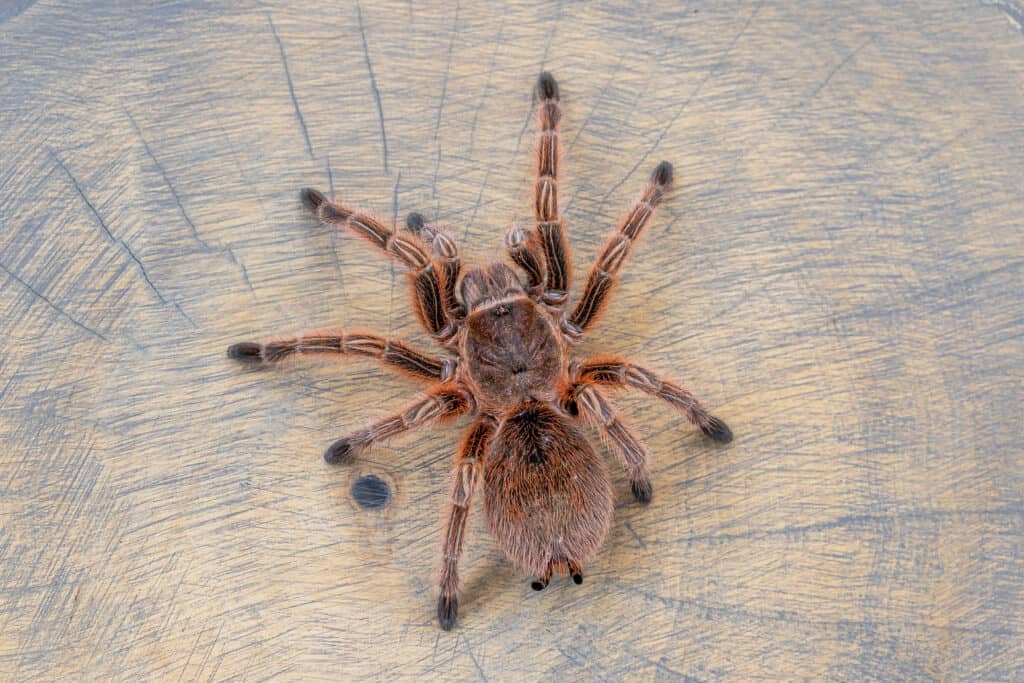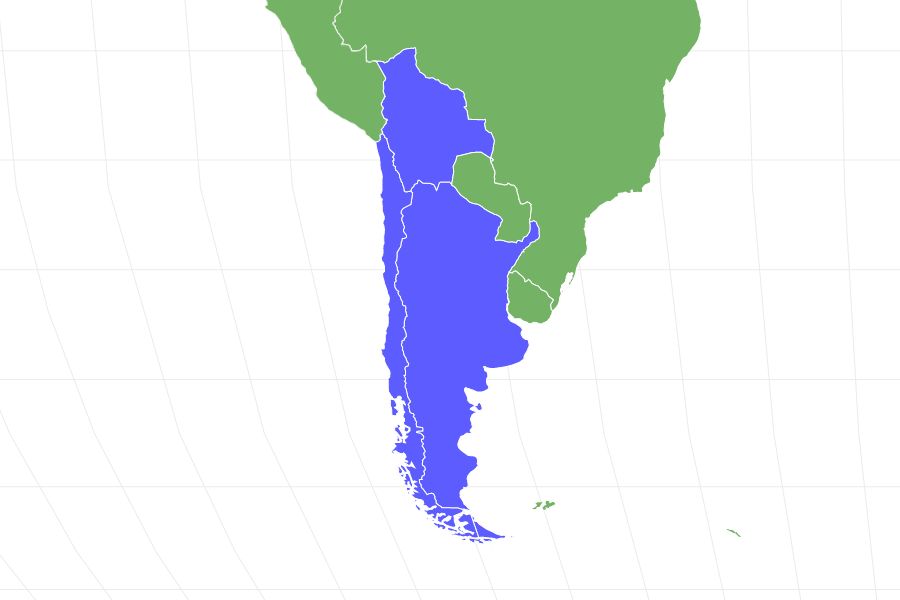Chilean Rose Tarantula
Grammostola rosea
They can cling to the side of an aquarium.
Advertisement
Chilean Rose Tarantula Scientific Classification
- Kingdom
- Animalia
- Phylum
- Arthropoda
- Class
- Arachnida
- Order
- Araneae
- Family
- Theraphosidae
- Genus
- Grammostola
- Scientific Name
- Grammostola rosea
Read our Complete Guide to Classification of Animals.
Chilean Rose Tarantula Conservation Status
Chilean Rose Tarantula Facts
- Prey
- insects, crickets, grasshoppers, frogs
- Main Prey
- insects
- Name Of Young
- spiderlings
- Group Behavior
- Solitary
- Fun Fact
- They can cling to the side of an aquarium.
- Biggest Threat
- Habitat Loss
- Most Distinctive Feature
- pink colored bristles/hairs
- Other Name(s)
- Chilean rose hair tarantula, flame tarantula, Chilean red-haired tarantula
- Temperament
- Mild mannered
- Habitat
- grasslands, desert, jungle
- Predators
- snakes, lizards, tarantula hawks (wasp)
- Diet
- Carnivore
- Lifestyle
- Nocturnal
- Location
- Chile, Argentina, Bolivia
- Migratory
- 1
View all of the Chilean Rose Tarantula images!
The most popular tarantula in the pet trade.
Chilean rose tarantulas are medium-sized tarantulas with rose colored hair. They are found in the South American countries of Chile, Argentina and Bolivia. Because of their docile temperament and pinkish hue they are one of the most common tarantulas in the pet trade. As adults they can have a leg span up to 4-5 inches with the females being bigger than the males. Females have a life span that is more than 20 years.
Amazing Chilean Rose Tarantula Facts
- They bodies and legs are covered in tiny bristles or hairs.
- Chilean rose tarantulas can adapt to a variety of habitats.
- They can be kept as pets and are easy to care for.
- Males and females go through molting to accommodate their growing bodies.
- They live in burrows in the ground and are nocturnal.
Chilean Rose Tarantula Scientific name
The scientific name of the Chilean rose tarantula is Grammostola rosea. Roseais Latin for “rose like” or “rosy”, referring to the pinkish hairs that cover their bodies. Other common names include Chilean rose hair tarantula, Chilean fire tarantula, Chilean red-haired tarantula and flame tarantula. In the pet trade they are sometimes affectionately referred to as Rosies.
Chilean Rose Tarantula Appearance

Chilean rose tarantulas are burrowing animals that can live in a variety of habitats. They are found in both dense jungles and dry
deserts
.
©iStock.com/Svetlana Makarova
There are three different colorations of the Chilean rose tarantula. Their bodies are all about the same color, dark gray, but the hair colors vary. One type has mostly grayish hairs with a few pinkish hairs interspersed. Another has mostly pink hairs and a third has a bright copper color. Quick note that they don’t actually have “hair” with the bristles actually being called setae, however for the familiarity of their look we will refer to it as hair.
When they reach adulthood they get to be around 3 inches long, the same length as a credit card, with a leg span of 4-5 inches. The females are a little more stout than the males. They have eight segmented legs along with two pedipalps at the front of their body that look like an extra set of arms. They are used for grabbing and holding prey and the males use them in mating.
Chilean Rose Tarantula Behavior
Chilean rose tarantulas are burrowing animals that can live in a variety of habitats. They are found in both dense jungles and dry deserts. They spend most of their time buried deep in their burrows only coming out at night to hunt for food. Chilean rose tarantulas are solitary animals with only one tarantula living in each hole. The entrance to the burrow is covered with a web to protect it.
At night Chilean roses come out to hunt for their prey. They use their size to overpower smaller animals like crickets, roaches, and grasshoppers. They grab their prey, bite with their fangs, inject it with venom and then ball it up with their webs. Using digestive juices they liquefy their victim before sucking their insides up for dinner. They can actually go for months without eating.
If a tarantula is threatened they can flick the urticating hairs off their back causing an irritation to the predator. They may also rear up on their back legs and wave their front legs, making a hissing noise to intimidate the predator.
Another unique behavior of Chilean rose tarantulas is that they secret silky webs from their feet, not just from their abdomens like other spiders. One research study showed how Chilean rose tarantulas were able to cling the side of a smooth vertical surface, like a glass aquarium, by making webs with their feet.
Chilean rose tarantulas are docile and have an easy going temperament. They rarely bite which is another reason they make good pets. They can be a little too low key as pets at times having periods where they move little to none, making them less exciting to watch.
Chilean Rose Tarantula Habitat
The habitat of Chilean rose tarantulas is grasslands, dense jungles or dry deserts. They live in Chile, Argentina and Bolivia. Most of the ones found in pet stores in North America are imported wild caught ones from Chile.
They seem to be able to adjust to a variety of habitats including the harsh climates of the Atacama Desert. They are equipped to dig deep into the ground to adjust to the current temperatures. Some will move into an abandoned burrow of other animals while others will dig their own. Coming out at night to hunt helps them avoid the hottest times of the day in the desert.
Chilean Rose Tarantula Predators and Threats
Predators of Chilean rose tarantulas include snakes, lizards, some birds, and tarantula hawks. Tarantula hawks are large wasps that can get to be 2 inches long. They have a metallic blue body with dusty orange wings. They actually capture and bury tarantulas alive, not saving them for a later meal for themselves but preparing for the first meal of their young. Before they bury the tarantula the female lays one egg on the tarantula’s abdomen then seals the spider in a burrow. When the wasp larvae hatch it starts devouring the tarantula. Harsh!
One tactic Chilean rose tarantulas use to avoid predators are to stay hidden in their burrows during daylight hours. During the night their setae (or bristles) work like sensory structures to alert them to movement. They do have fangs and can bite releasing a venom which they also use as a defense mechanism, although they are more likely to flee than fight.
What Eats Chilean rose Tarantulas?
Snakes, lizards, some birds, and tarantula hawks (a wasp) eat Chilean rose tarantulas.
What Do Chilean Rose Tarantulas Eat?
Chilean rose tarantulas diet consists mostly of insects like crickets, grasshoppers and roaches but it will also eat small lizards, frogs and mice. They can go for months without eating which seems to be an adaptation due to the harsh conditions they may live in. For captive Chilean rose tarantulas it is recommended to feed them 6-8 crickets a month in the warmer months and they only need 1-2 crickets a month in the cooler months. Not big eaters!
What is the Conservation Status of Chilean Rose Tarantulas?
Chilean rose tarantulas are not listed by the IUCN as a threatened species. They are readily available in the pet trade so they seem to have a healthy population.
Reproduction, Babies, and Lifespan
When male Chilean rose tarantulas reach maturity, somewhere between 5-8 years old, they leave their burrows in search of a mate. When they find a burrow of a female they use their leg to tap near the entrance of the burrow. If the female is ready to mate she will come out of her burrow and the passive aggressive dance will begin. The male instinctively knows that the female will try to eat him so he must carefully try to hold her in place to deposit his sperm while avoiding being eaten. He transfers his sperm to a sperm web, then onto his pedipalp to insert into the female. If the male gets away he may mate with other females. Even if he does initially survive, the males die a few months after mating.
Female Chilean rose tarantulas lay around 50-200 eggs each year. They create an egg sac by spinning a web around them to keep them safe. The mother then keeps the sac in her burrow watching over the eggs. She will turn them periodically to keep the sac even. Tiny spiderlings hatch within a few weeks and spend another few weeks underground in their mothers burrow before venturing out.
Before getting Chilean rose as a pet be sure you are aware that they can live a long time. The lifespan of females is really unknown because they have been introduced as pets not yet 20 years ago. However it is assumed they are similar to other tarantulas with the females living 20-25 years. The males have a much shorter lifespan averaging 7-8 years with 10 years being reached by some. The males mate after their final molt and then are either killed by their female mate or die a few months after mating.
Population
Due to the wide range of their habitat and their burrowing lifestyle it is difficult to get an accurate count. They are not hard to find in the pet trade so it seems they have a healthy population.
Related Animals
View all 235 animals that start with CChilean Rose Tarantula FAQs (Frequently Asked Questions)
Are Chilean rose tarantulas friendly?
Yes, they are docile and don’t seem to mind being handled.
Are Chilean rose tarantulas venomous?
Chilean rose tarantulas are venomous but they have a mild venom. Their venom is not harmful to humans and they rarely bite.
How much do Chilean rose tarantulas cost?
The cost varies but the range is $60-$100.
Do Chilean rose tarantulas make webs?
They make webs to block the entrance to their nest and to wrap up their eggs but they do not use a web to catch prey for food.
Are Chilean rose tarantulas good pets?
Yes, Chilean rose tarantulas make good pets. They are the most common tarantula in the pet trade.
Can you keep more than one Chilean rose tarantula in the same home?
No, they need to have their own enclosure. They are solitary animals and prefer to live alone.
Are Chilean rose tarantula carnivores, herbivores, or omnivores?
Chilean rose tarantulas are carnivores.
How big do Chilean rose tarantulas get?
They can get to be 2 ½ -2 ¾ inches as adults.
Thank you for reading! Have some feedback for us? Contact the AZ Animals editorial team.
Sources
- American Tarantula & Animals, Available here: https://www.atshq.org/category/tarantula/
- Tarantulas, Available here: http://tarantulas.com/
- Smithsonian's National Zoo & Conservation Biology Institute, Available here: https://nationalzoo.si.edu/animals/chilean-rose-tarantula

















